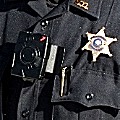- By Marcia E. Lynch
- News
 Print
Print  The Legislature’s Public Safety Committee continued its discussion of body cameras, reviewing the draft Sheriff’s Office General Order that would govern use and operation of the cameras, including measures required to secure and safeguard digital evidence captured by the cameras. Use of the cameras, as described in the draft order, is intended to assist officers in the performance of their duties, increase transparency and accountability in operations, and gather evidence for use in the prosecution of crimes. Tompkins County Sheriff Ken Lansing and Undersheriff Brian Robison appeared before the committee to explain the draft order and respond to Legislators’ questions.
The Legislature’s Public Safety Committee continued its discussion of body cameras, reviewing the draft Sheriff’s Office General Order that would govern use and operation of the cameras, including measures required to secure and safeguard digital evidence captured by the cameras. Use of the cameras, as described in the draft order, is intended to assist officers in the performance of their duties, increase transparency and accountability in operations, and gather evidence for use in the prosecution of crimes. Tompkins County Sheriff Ken Lansing and Undersheriff Brian Robison appeared before the committee to explain the draft order and respond to Legislators’ questions. The draft document states that it is the policy of the Sheriff’s Office for officers to activate the recording function of the body-worn cameras when engaged in law enforcement operations—that every officer assigned to the Patrol Division must wear a body camera when on duty, and all other officers must wear one when reasonably expected that the officer will engage in law enforcement operations during the officer’s shift. Body cameras must be worn by officers assigned to
Special Weapons and Tactics (SWAT) or Critical Incident Negotiating Team (CINT) operations when responding to such calls. The draft order sets detailed requirements for aspects including maintenance, activation and duration of recording, maintenance of access to, and retention of videos, and training standards.
In response to some committee members’ questions regarding access to video records by defendants and the public, County Attorney Jonathan Wood advised that provisions regarding such access would fall under the rules of evidence proscribed under Criminal Procedure Law and under Freedom of Information Law regarding public records.
Committee Chair Nate Shinagawa pointed out one aspect of the policy that he sees as especially significant in terms of minimizing potential risk—that in the event of an officer-involved shooting, whatever its nature, the highest ranking officer at the scene is responsible for taking possession of the cameras of all officers at the scene at the time of the incident at the conclusion of each cameras’ recording and preserving the evidence on the cameras for later review.
Legislator Jim Dennis noted that the issue of body cameras is all about changing people’s behavior, that in today’s society where everyone is taking pictures, he wants the cameras on officers to provide that record.
Undersheriff Robison reported that discussions are still in progress regarding how data storage will be handled through the County’s Spillman emergency services data system and that until that issue is fully resolved an implementation date for the body camera program cannot yet be projected.
On another matter, Undersheriff Robison told the committee he’ll be back before the committee next month to request a mid-year adjustment in the office’s 2015 budget to compensate for overages in salary and jail board-out lines. County Administrator Joe Mareane told the committee the County’s 24/7 operations, also including the Department of Emergency Response, are seeing overtime pressures.
v11i29
